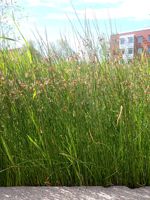Mon-Fri 9am - 5pm Mountain time
Beaked Sedge vs Baltic Rush
Carex utriculata
Juncus balticus
CUSTOM GROW
CUSTOM GROW
Beaked Sedge is a native perennial wetland plant that forms dense clumps of tall, grass-like stems. It produces distinctive beaked seed heads that mature from late spring into summer. The plant provides food for waterfowl, muskrats, and other wildlife, while its dense growth offers cover for birds and small mammals. Its flowers and seed structures contribute to pollinator and invertebrate habitat in aquatic ecosystems.
Thriving in saturated soils and shallow water, Beaked Sedge is common in marshes, fens, and riparian zones. Its rhizomatous growth enables it to spread into large colonies that stabilize soils and support overall wetland health. Hardy and low-maintenance once established, it is well-suited to riparian plantings, naturalization, and ecological restoration projects.
Baltic Rush is a widespread native perennial rush that forms dense clumps of upright, cylindrical stems. Well adapted to saturated soils, it is common in wetlands, streambanks, and riparian zones, and is tolerant of both fresh and saline conditions. Hardy and low-maintenance, Baltic Rush contributes to soil stabilization and enhances wetland habitats.
It offers cover for small animals, nesting habitat for birds, and limited forage for livestock when young and tender. Its dense growth and rhizome networks add structural diversity that supports wetland ecosystems, making it well-suited for riparian planting, shoreline stabilization, wetland restoration, and reclamation projects.

